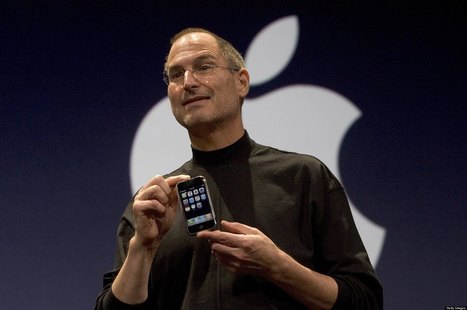 Your new post is loading...
 Your new post is loading...

|
Scooped by
Linda Holroyd
January 15, 2013 4:43 PM
|
I always enjoy catching trends at the annual Consumer Electronics Show—not so much to see the latest gadgets but to gauge progress and how these trends translate into the industries we follow.

|
Scooped by
Linda Holroyd
January 9, 2013 1:42 PM
|
The Place To Talk TechComm

|
Scooped by
Linda Holroyd
January 3, 2013 2:38 PM
|
Salespeople are always the early adopters. Here's where they (and you) are heading. SALES SOURCE | Geoffrey James Getty THE FUTURE OF SALES? It is now possible to scan the brains of people viewing sales presentations to see whether or not they’re being convinced. For the past two decades, salespeople have been the early adopters of technology that's later permeated the rest of the business world. Salespeople, for example, were the first to embrace smartphones and CRM was the first viable "cloud-based" application. Therefore, if you want to know how the general business public will be using computers in the future, you'd best understand the trends that are already taking place within forward-looking sales teams. To this end, I've been working with sales research pioneer Howard Stevens on a book about the future of selling. We have just completed the chapter on sales technology which (along with other chapters) is available for free on the Chally website (HERE). 1. Cold calling will become impossible. Today, all companies use some form of voice mail, which provides an automatic and relentless gatekeeper. While sales technology firms have come up with technologies (like autodialers) to overcome these barriers, many decision-makers (especially young ones) no longer use voice mail and only take calls from recognized numbers. At the same time, there's been an increase in government regulation of cold calling. Member states of the European Union, for instance, are now required to have laws that prohibit general cold calling. While cold calling remains legal in the United States, the FTC's "Do Not Call List" has greatly curbed unsolicited telemarketing. The combination of these two factors is already making cold calling less effective at lead generation. Because of this, we see salespeople already migrating to other lead generation methods, such as developing customer relationships using a combination social media and other "known-person to known-person" communication. 2. Tablets will replace laptops (and maybe desktops). When the iPad was originally released, Walt Mossberg of The Wall Street Journalcalled it a "pretty close" laptop killer. There are now growing signs that that "pretty close" was an understatement. For example, a recent study revealed that 89% of iPad owners bring their iPad when traveling and more than one of three leave their laptop at home. Within 90 days of its introduction in early 2010, the iPad managed to penetrate 50 percent of Fortune 100 companies and by 2011, iPad sales were eating into PC sales. Microsoft recent announcements identifying its Surface product as key to the company's future indicates the Microsoft takes the tablet threat seriously indeed. While it is currently too soon to tell for certain, we remain deeply skeptical of the ability of Microsoft's Surface tablet to establish itself as a third alternative in the tablet market. While there's no question that Windows machines will remain a fixture in the business world for many years to come, we feel the days of the dominance of the desktop and laptop inside sales teams is drawing to a close. 3. Sales management will become more data-driven. Sales management has always been data-driven; few corporate metrics are more visible than sales figures! However, because sales revenue measures after-the-fact result, sales executives don't know whether their strategies are actually responsible for revenue increases. As a result, most sales managers rely primarily on intuition and tradition when making important decisions. For example, companies spend billions of dollars every year on sales training that attempt to "clone" the winning behaviors of top salespeople, even though there's no data to show that such training improves overall sales performance. Increased data gathering through CRM and survey vehicles is now making it possible to gather and analyze demographic and performance data about sales personnel. This scientific process often reveal that the "intuitive" truths about sales management are dead wrong. Top salespeople, for example, always build their success on pre-existing natural talent that tends to be unusual in the general population. A data-driven approach to sales management thus allows companies to re-target sales training to making average performers slightly better rather than wasting time trying to turn them into stars. 4. CRM will become invisible. Historically, CRM implementations have had a failure rate as high as 70%, according to some studies. Experts believe that such failures have been largely due to a mismatch between the needs of sales management (i.e. control over the sales process) and the needs of the salespeople (i.e. control over their customer relationships.) However, CRM systems are gradually becoming "smarter" in the way that they use existing information, greatly reduce the amount of clerical work required of the sales team. Tablets and smartphones will make CRM both less burdensome and more customizable and therefore more attractive to sales teams. We believe that we're on the brink of a sales technology environment where the accumulation of customer data becomes automatic and CRM thus becomes an more or less invisible part of the overall computing environment, in the same way that Ethernet and email are now simply assumed to be part of the general business tool kit. 5. Interactive video will become ubiquitous. Video conferencing has been around for over two decades, but has not yet played much of a role in sales environments. However, we believe that this will change over the next decade, and that video interaction will permeate the sales environment, primarily due to the increase use of smartphones and tablets in sales environments. Fueled by online applications like Skype, the video conferencing marketing has been growing rapidly and the integration of video conferencing into iPhones, iPad and other table devices has turned videoconferencing from a specialized application to a preferred way for people (especially young people) to communicate. We predict increased usage of video conferencing for holding online events, creating collaborative sales proposals, sales training, product demonstrations and ongoing customer service. Overall, we believe that interactive video is likely to largely replace in-person meetings for all but the biggest ticket sales items.

|
Scooped by
Linda Holroyd
December 31, 2012 7:39 PM
|
Ten Truths about the New Sales Professionals By Linda Holroyd, CEO, FountainBlue The sales heroes of the 80s and 90s often left me with a sense of oil and grease – to me, they were people who were more slick and connected wheeler-dealers than consultative, customer-oriented providers. No longer are we in an age of buying-what-you-don’t-need, with money-you-don’t-have, to impress people-who-don’t-care. The economic meltdown precipitated both the aftermath of Y2K (no disaster, reduced IT spending) and 9/11 (which created a global culture of suspicion and caution) coupled with the empowerment of the user (through Google and Yahoo with its search, through Oracle and IBM and its big data solutions, through FaceBook and LinkedIn and Twitter with social media, through consumer-based e-commerce solutions like Amazon and eBay) is driving the age of personalization, and revolutionizing the sales process. As marketing professionals and leaders, we need to understand and support the next generation of successful sales professionals: They will be more customer-oriented, so help them profile their customers and prospects, and communicate with the team in delivering what the customers want. 1. The new breed of sales professionals will truly and genuinely understand the current and anticipated needs of the customer, and great leaders will reward them for doing so. 2. Indeed, they will consider the needs-of-the-customer above their own immediate needs, even if it means walking away from a sale or even directing them to another, even competitive solution. The old type of successful sales professional will have a difficult time adapting to the concept, and the new sales professionals will not look and feel the same as successful sales professionals of the past. They will be more tech-savvy, so develop the tools to help them do their job well. 3. The new generation of sales leaders will increasingly better understand enough about databases and software to know what can be efficiently customized. 4. Indeed, they will understand the types of solutions which can leverage technology to be personalized, and the types which would be difficult to make efficient, seeking scalable, customizable solutions for their customers. They may be a current sales professional who sees things differently, or someone from another field who gets-the-tech, and wants to apply it to address specific customer problems. They will astutely leverage social media to spread the word and reputation, and it will take a successful partnership between sales and marketing to make this work! 5. The new sales professionals will proactively leverage social media and reputation management solutions to credibly spread the word about company offerings. 6. Indeed, the more experienced and savvy professionals will recruit and incentivize ambassadors to spread the word to identified niche audiences. They will be more collaborative, at least the successful ones will be, and it’s a great opportunity for marketing and sales to bury the hatchet and find a path forward, together. 7. The new sales professionals will work with product marketing, development and marketing to ensure that the company understands and delivers precisely what the customer needs in the short term, and even anticipates what the customer will need in the longer term. 8. In fact, they would willingly mentor others sales people to better deliver solutions to customers, and understand the value of doing just that. This is a new-world-order way of looking at sales, and goes against the grain of sales-professionals-of-the-past, who covet and protect their leads, their territory, their knowledge and skills so that they can reap rewards beyond their peers. They will be more proactive, and let’s hope partnering with marketing leaders to deliver all of the above. 9. The new sales professionals will follow the trends and manage and even anticipate the evolving needs of the customer, and proactive approach customers about how trends would impact their business and offerings and what they can do to address these shifts. 10. Indeed, they will learn from the needs and deliverables for one customer/company/industry, and be able to generalize offerings to others while optimizing customization and while conducting business at the most ethical levels. The bottom line is that the new successful sales person is someone who is intelligent, articulate, genuine, collaborative, informed, proactive and tech-savvy, and they may or may not be in sales now. They are someone you would trust implicitly to put your company first. Where do you think we should find them? How can we groom them? Your thoughts are welcome. E-mail us atinfo@FountainBlue.biz. This blog is part of FountainBlue’s Marketing Leadership in an Age of Personalization Series and is copyrighted 2013. All rights are reserved.

|
Scooped by
Linda Holroyd
December 18, 2012 12:12 PM
|
Marketing Leadership in an Age of Personalization
Building Social Currency for Your Business
November 29, 2012 by Linda Holroyd, CEO of FountainBlue
FountainBlue’s monthly top-ten rules of marketing are designed to guide our client entrepreneurial tech companies and the community in general on marketing practices that clearly communicate and connect, thereby generating momentum for people and organizations. This month’s top-ten-marketing rules topic will be on the top ten ways to build a community around your business, leveraging non-tangible social currency.
If you go with the tenet that momentum is at the heart of all business successes, then it follows that in the new age of building business where the consumer is king and technology is leveraged to deliver custom solutions, then creating a community around your business, engaging stakeholders at all levels through social currency is paramount for the business. Below are ten ways to build a community around your business, leveraging non-tangible social currency.
Find Win-Win Opportunities to Engage Select Ambassadors.
1. It’s a win-win if your company brand can enlist the right ambassador(s) to complement and extend that brand. It’s good for the company, and good for the community and individuals as well.
2. You could also enlist ambassadors by geographic location, extending your current brand and reach beyond what currently exists. It’s a win for the company as they extend to new territory, and a win for your ambassadors, who can associate with a respected brand, service and product, and extend the value and the reach of same.
Recruit Contributors and Managers to build the message and the community.
Content experts add credibility to your community, and create relevant, timely content which educates, informs and engages. They gain social currency by writing on-topic to a relevant community and followership and receive recognition and esteem for doing so.
4. Activists can moderate community discussions on relevant topics while participating in the vibrancy and viability of the community, which benefits all.
Promote and Reward The Participation and Involvement of Your Advocates.
Recognize your community leaders on the web site, in meetings and events, every chance you get. Many of the most engaged leaders respond well to this, provided that it is done well, and provided that they see fellow contributors as their peers.
Additional social recognition for the most eager and enthusiastic supporters can be very motivating for all, providing that this is done fairly and well.
7. Tangible rewards are also at times appreciated, but generally not as coveted as social, non-tangible rewards for the most part.
By definition, your advocates will be closer-to-the-needs-of-the-customer than you are, so Enlist Their Input about how to better serve people like them.
8. Start with the needs and challenges of the customers rather than with a technology innovation which may serve the customer.
9. Develop and enhance your user interface to meet the needs of your customers.
10. Get insights from your advocates on how to expand technologies and brand into new markets.
We conclude that marketing has evolved with the times, and it will be much more about authentic advocacy, committed volunteers and social currency than it will be about PR, search engine optimization and ad-buying, although that will remain important. The challenge is to build that community and social currency that benefits all.

|
Scooped by
Linda Holroyd
December 11, 2012 11:29 AM
|
The hospitality industry decrying Airbnb. Taxi companies trying to shut down peer-to-peer car services. Comedian Louis CK selling a $5 video directly to his fans. oDesk's global online marketplace

|
Scooped by
Linda Holroyd
December 10, 2012 3:50 PM
|
Crediting mobile, apps and user-generated content for LinkedIn's stellar year

|
Scooped by
Linda Holroyd
December 7, 2012 12:26 PM
|
What does it mean for you and your business if "More of the ultra-rich are giving philanthropically at an earlier age, and aiming to die with their bank accounts nearly empty"?

|
Scooped by
Linda Holroyd
December 6, 2012 1:50 PM
|
Of course you would find WSJ, Forbes, CNBC and Fortune on the list, but consider also following the CEO of Manpower and the CEO of LinkedIn

|
Scooped by
Linda Holroyd
December 4, 2012 12:48 PM
|
This article provides specific examples of how companies are successfully engaging their customers to create ads, brands and messages that resonate authentically. "Advertising and marketing are changing and more than ever, and it's the customers who are pulling the strings."

|
Scooped by
Linda Holroyd
November 29, 2012 6:30 PM
|
What Leading With Vision Really Means BY ERIKA ANDERSEN | NOVEMBER 21, 2012
The essence of farsightedness in business is not simply envisioning a possible successful future--it's being able to articulate it in a way that’s both compelling and inclusive. We are drawn to leaders who articulate a possible future in a way that speaks to us and includes us. Farsighted leaders use their clarity of vision and their articulation of a successful future to pull people out of fear or shortsightedness and into hopefulness and a sense of purpose. People want leaders who look beyond today. They want to have the sense there is a master plan to carry them through whatever short-term trials and tribulations arise. (The recession! The crazy media landscape! Lions and tigers and bears, oh my!) They look to the leader to articulate, in a compelling way, a clear and positive future state toward which they can direct their efforts. When leaders focus only on the current crisis or this quarter’s numbers, it seems to us that they’re more interested in maintain the status quo or protecting themselves than in creating a successful future. They are not seen as leaders. People also want to see that the leader’s farsightedness is based on a deep sense of what’s necessary, right, and good for the business and the team rather than what’s simply expeditious, popular, or self-serving. We want to feel that our leaders’ “far-sight” is focused on the greater good, that their vision promotes the group and not just their own selfish interests. A truly farsighted leader envisions a possible future that responds to and resonates with people’s aspirations for their individual and collective success. When employees or potential employees hear about the good leader’s vision, their visceral response is, “Yes, I want to go there too.” This is not to imply that the visionary leader simply goes for the easy win, then thing to which people will most easily commit. True visionaries often see possibilities where other see difficulty and dead-ends. Most people in the first decade of the twentieth century saw motorcars as a fad for the rich, a frivolous and uncertain fancy that would never replace the dependability of the horse. Henry Ford’s vision of a nation where every family would have an automobile seemed laughable, impossible, and even dangerous. Only the clarity of his vision and his consistency in moving toward it brought the support from others that he needed to make his vision a reality. This brings up a critical point about farsightedness: the leader must not only articulate her vision; she must live it. It can’t be something she dusts off for quarterly staff meetings. People must witness the vision serving as the leader’s compass. She must use it as a screen for strategy and action. True farsightedness in a leader is both practical and aspirational. A clear and compelling vision can drive extraordinary business results. It provides a focus for people’s decisions and actions, and it creates that feeling of “tribe” that most people find necessary and motivating. This quality of leadership is especially important when the enterprise is a new one and the future is uncharted. One stunning example of this kind of farsightedness is how Steve Jobs operated at the start of Apple. When Jobs and Wozniak founded Apple Computers in 1976, the personal computer was still new and untested. Moreover, the idea that almost everyone would one day have a computer and that computers would be as accessible and easy-to-use as televisions or telephones seemed like craziness. But then along came these two young men with exactly these ideas. And Jobs, especially, continued to articulate this possible future in a way that brought together capital, a workforce, and a marketing plan that ultimately led to the achievement of the future he envisioned thirty-five years ago. The essence of farsightedness is not only envisioning a possible successful future but also articulate it in a way that’s both compelling and inclusive. Compelling means that it’s meaningful to those who hear it, that it’s attractive to them. Inclusive means they want to help make it happen and feel they can have an important part to play in moving toward it. Clearly Steve Jobs was able (I encourage you to watch any of his company presentations on YouTube or at the apple.com Web site) to express his vision for the future in this way. In January 1984, when Jobs introduced the first Macintosh computer at Apple’s annual shareholders’ meeting, an attendee described the level of enthusiasm as “pandemonium.” As the first commercially successful small computer with a graphical user interface, the Macintosh represented, and still represents, the realization of a vision that was both compelling and inclusive. How to be farsighted You may be thinking, Okay, but how do I become more farsighted if that’s not one of my strengths? Fortunately, my colleagues and I have gotten clearer over the years on the specific behaviors that make up each of these leadership attributes. We start with farsighted. When you deconstruct this element, these are the key behaviors of which it consists: Leaders who are farsighted:
1. See possible futures that are good for the enterprise
2. Articulate their vision in a compelling and inclusive way
3. Model their vision
4. See past obstacles
5. Invite others to participate in the vision For more leadership insight, sign up for the Fast Company newsletter. Excerpted from Leading So People Will Follow (Jossey-Bass; October 2012) by Erika Andersen. All rights reserved. Erika Andersen is a nationally known leadership coach and the founder of Proteus International, a consulting, coaching and training firm focused uniquely on leader readiness. She is the author of Leading So People Will Follow (Jossey-Bass; October 2012).

|
Scooped by
Linda Holroyd
November 26, 2012 2:03 PM
|
Predicting more customer-centric marketing activities: more choices, more functionality, more advanced tactics involving dynamically generated metrics. "The ways in which consumers discover, consume and engage about products and services, makes the B"B marketing space as blurry as the consumer one."

|
Scooped by
Linda Holroyd
November 20, 2012 2:32 PM
|
By 2015, about one quarter of all companies will have a chief digital officer, Gartner says. . . Gartner Distinguished Analyst David Willis at the Symposium/ITxpo 2012 comments that “The Chief Digital Officer plays in the place where the enterprise meets the customer, where the revenue is generated and the mission accomplished. They’re in charge of the digital business strategy. That’s a long way from running back office IT, and it’s full of opportunity.”
|

|
Scooped by
Linda Holroyd
January 10, 2013 3:28 PM
|
Six years ago on Wednesday, Steve Jobs took to the stage to introduce Apple's newest product. He called it the iPhone, and said that he and Apple wanted to change the idea of a phone the way they had changed the personal computer.

|
Scooped by
Linda Holroyd
January 9, 2013 12:35 PM
|
Loren Alhadeff didn't know what to expect when his senior sales reps at Docusign...

|
Scooped by
Linda Holroyd
January 3, 2013 2:34 PM
|
Ann Miura-Ko, a co-founding partner at Floodgate. As the new year begins, we asked several venture capital investors to reflect on the past year and give us their outlook for 2013. As the new year begins, we asked several venture capital investors to reflect on the past year and give us their outlook for 2013. Continuing our series is Ann Miura-Ko, a co-founding partner at Floodgate. Miura-Ko speaks about technical innovation coming out of universities and research organizations, the need to make the interface of mobile commerce different on different devices, and the potential of mobile in enterprise. Looking back, how would you characterize 2012? An amazing year for real technical innovation out of our universities to start making impact as real companies. Two of my investments are companies borne out of PhD research at Stanford–Inscopix and Ayasdi. What is the most important issue that the venture capital industry faces in 2013? It’s the same issue that venture capital faces every year: Who will invest in the top 15 companies of 2013? That’s really the only question that matters. What do you see as the biggest investment opportunity for venture capital in 2013? (a) Radical science: Technical innovation coming out of our universities and research organizations. This is a distinct shift away from consumer or consumer-ization of anything. I have seen really interesting technical insights with real commercial potential this past year and I think that trend will continue. It requires investors to be technically savvy–you won’t be reading business plans or trying out applications on your phone. Most of these insights are in academic papers. What’s interesting is that they aren’t just pie-in-the-sky technical thoughts but rather ideas that have a real path to implementation with low capital requirements. (b) Mobile commerce I’ve seen in my e-commerce investments that people are shopping on their mobile devices. To date, the experience is the online experience translated for mobile but I believe that mobile commerce, as an interface, will have to be different. On the phone it’s about instant gratification or getting the shopping done quickly. On the tablet it is about browsing images almost the way you would a catalog at home. These experiences should translate into something different and interesting. (c) Mobile meets enterprise With mobile becoming pervasive within enterprises both as BYOD and company-sanctioned devices, the use of mobile to gather and disseminate information is potentially way more powerful than combining social with enterprise applications. One of our portfolio companies, DoubleDutch, has shown the power of mobile particularly with sales organizations providing them with a mobile-first CRM application. Another of our portfolio companies, Xamarin, has had tremendous traction amongst C# developers (many of whom are within enterprise organizations) by providing them with a way to create native applications on iOS and Android platforms. These companies are early signs of the tremendous potential of mobile in the enterprise space. What is your New Year’s wish for the industry in 2013? I hope for the continued courage of entrepreneurs everywhere to dream the big dream and to fight the big fight and for investors to believe early and with a great deal of patience. –Interview by Lora Kolodny.

|
Scooped by
Linda Holroyd
December 21, 2012 12:05 PM
|
It’s now time to turn our attention next year’s biggest entrepreneurial trends. Here’s my take on trends entrepreneurs should watch in 2013: 1. Crowdfunding With the flow of capital to entrepreneurs becoming smaller and smaller each year, we’re likely to see an even greater rise in crowdfunding platforms. In fact, these collectively generous communities are estimated to transact as much as $500 billion in 2013. 2. Going Global Today's technological world allows us access to customers from all over the globe. Bringing successful U.S. business models into developing or trailing countries presents an opportunity for startups in every industry. Startups like Pheed, 2U, and Threadless have already made the jump into the global waters with successful outcomes. 3. Augmented Reality Moving past the mobility wars that have taken place in the smartphone sector, brands like Apple and Microsoft are making the move to augmented reality. With the release of Google’s Project Glass prototype--the augmented reality head-mounted display revealed back in June--this sector is certainly an area for tech entrepreneurs to keep their eyes on in 2013. 4. L.A. As Tech Startup Hotspot Earlier this year, L.A was ranked tenth on PayScale.com’s list of Hotspots For Startup IT Jobs. With the help of accelerators, L.A. will continue to grow at a hotspot for startups in 2013. After starting my web design company in L.A., I’ve been able to see the unmatched level of talent and opportunity available in the area, which will only get stronger throughout the next year. 5. Business Focus For Startups Startups that have a bigger focus on business and revenue models are set to succeed in 2013, drawing away from businesses with a focus on big ideas and user acquisition with no clear cut revenue model. 6. Better Social Platforms The need for higher quality content online will certainly drive a social trend in 2013 with the creation of more advanced content-driven social networks. Pheed is an example of a social platform that I feel will reach even larger audiences in 2013. 7. Great Emphasis On Company Culture Creating a positive company culture will be of stronger emphasis for startups in 2013. Many startups are taking new steps toward building cultures that define their products. One step I firmly believe in: dismantling hierarchies, which can eliminate micromanaging and other attitudes that squash innovation. 8. Corporate Incubators For Funding The trend of corporate-backed funding, known as “corporate incubators,” are certain to take 2013 by storm. While these funds will ultimately provide smaller amounts of support than traditional venture capital funds, they will be able to support a larger number of innovators and have a greater impact long term. 9. Internet TV The growth of internet usage has spawned the next generation of television -- Internet TV. In 2013, I expect Internet TV to take off with the help of Google and Apple TV, leaving space for new innovations in this market.

|
Scooped by
Linda Holroyd
December 11, 2012 11:33 AM
|
One of the top venture capital investors says the venture model is not broken for firms that know what they're doing.

|
Scooped by
Linda Holroyd
December 11, 2012 11:27 AM
|
We usually look at business as a competitive game, a game like basketball, in which there is a winner and a loser. On a daily basis, business often feels like a war: One business lives and the other

|
Scooped by
Linda Holroyd
December 7, 2012 12:29 PM
|
The cloud will evolve, becoming better defined, better integrated and more mainstream . . . "As enterprise steps up its use of cloud services analyst house Forrester has predicted how business use of cloud platforms and services will change next year."

|
Scooped by
Linda Holroyd
December 6, 2012 3:43 PM
|
Instead of casting a wider net, create an emotional experience that's so sticky, so engaging, so compelling that they don't want to leave

|
Scooped by
Linda Holroyd
December 4, 2012 1:05 PM
|
Yes, mobile, big data, and IT are recognized as hot trends, but what are the opportunities for specialized and smaller tech solutions, particularly in emerging markets?

|
Scooped by
Linda Holroyd
December 4, 2012 12:42 PM
|
Interesting graph on how Apple and Android are eating into the Wintel market. "Mary Meeker's huge, well-researched slideshows are a treasure trove of data on the state of the Internet. Here's her latest, with highlights called out by VentureBeat."

|
Scooped by
Linda Holroyd
November 27, 2012 2:26 PM
|
Global trends for 2013 A top ten for business leaders Nov 26th 2012, 11:01 by J.A. Cassandra is obviously not the only forecaster, and sadly on occasion this particular modern-day soothsayer fails to match the infallibility of his classical forebear. I say this because the England cricket team, despite my dire predictions of disappointment, has today handsomely defeated India in Mumbai. So, it is in a spirit of humility that I offer these predictions for 2013 from alternative (I am loth to say rival) forecasters, Professor Thomas Malnight of the IMD business school in Lausanne and his colleague Tracey Keys of Strategy Dynamics Global. Looking down their ten trends, I find myself general in agreement (though I'm not as pessimistic as they are in number 7, and we have to bear in mind that a lot of what they say is more relevant to the years well beyond 2013). And quite what they mean by the "ownerless economy" in number 2 is a bit of a mystery…Still, well worth pondering, and well worth looking at the Globaltrends website. Meanwhile, here is their potted version: The great power shift 10 trends business leaders need to watch in 2013 Thomas W. Malnight and Tracey S. Keys The great global redistribution of economic and social power will continue over the next 12 months. Power will flow away from traditional institutions that have failed to deliver progress – especially governments and banks. It will flow towards communities and individuals, and also to businesses whose leaders understand and act on the big trends shaping our future. This future looks uncertain and unstable. Hurricane Sandy was a deadly reminder of shifting climate patterns, emphasizing the need for new ways to manage the world’s resources and environment. There are growing levels of social unrest over rising inequality, austerity, unemployment, political ineptitude, institutional failure and more. And companies will continue to fail because they misread the future - like Kodak, which invented the digital camera but filed for bankruptcy after focusing on its core film business instead. In our new Global Trends Report for 2013, we highlight 10 trends that business leaders need to focus on today. These are: 1.Social everything: New generations and their digital world stepping forward Social technologies are now a central part of everyday life and work. The social generations are reshaping companies from the inside, helping them to build broader, more agile networks to create and deliver value to customers. Mobility and connectedness will be at the heart of the future business environment: communications and marketing are moving from a focus on one-to-one relationships, to many-to-many. 2.Redefining value: The consumer is winning the fight to own the new consumer The notion of value is being redefined for the 21st century. Consumers have choice. They want personalization, and to participate in value creation, shifting the mindset to “made with me.” Value will also be about “shared with me” as the ownerless economy expands. This will be driven particularly by younger generations who value experiences they can share – and that also deliver benefits to society - over possessions. 3.Distributed everything: Mobility in production and consumption Mobility is entering a new stage. Not only does consumption occur anywhere, anytime, but the tools and resources to create and capture value are more broadly distributed too. Work is becoming increasingly distributed. Small-scale manufacturing, including 3D printing, will reshape production. Renewable technologies are distributing energy production, while mass teaching platforms are revolutionizing education. Ask what can’t be distributed, not what can. 4.The next “industrial” revolution: Robots and smart machines reshaping work Smart machines and robots will redefine society. Robots are now being deployed as receptionists, banking assistants and even prison guards, while technology allows amateurs to do what professionals once did. The upside: addressing issues such as caring for ageing populations. The downside: huge job losses. Yet the next wave of smart machines will also create new kinds of jobs. The challenge will be to ensure a workforce that is ready and skilled for them. 5.The new space race: Pushing the frontiers of technology once again? Scientific advances from national space programs have had a significant impact on how we live and work, from advanced materials to global telecommunications. Now, commercial space travel and exploration is a reality, even as a new space race hots up, particularly between the US, China and Europe. New advances will surely result, as will questions over the ownership of space “assets,” and whether advances will be shared for public benefit. 6.Geopolitical wars: The fight to control the future The BRICS and Beyond (other rapidly growing economies) will be where the fight to control future economic growth and social development will take place. It’s a multipolar market landscape, based on dramatically different economic, social and political systems. Politicians, along with companies, are still trying to find and control their place in the new world order, even as trust in governments falls, nationalism rises, and power shifts towards the people. The potential for radical political shifts at home and between nations is rising. 7.Resource wars escalating: From a world of abundance to shortage As the world’s population moves towards 9 billion by 2050, resources are under pressure, exacerbated by climate change. By 2030 we will demand twice as many resources as the planet can supply – risking social unrest and conflicts as people and nations compete for ever scarcer resources. Scarcity is already driving resource price volatility and cross-border investments. New technologies and rethinking consumption will be critical in future – with businesses rather than governments likely to lead the way. 8.Business stepping up: From profit to purpose Many businesses are stepping up to a new role, often with partners, to tackle social and economic challenges. Corporations are seeking to build legitimacy – and the license to operate – in the eyes of demanding consumers, employees and stakeholders who care about the impact and motivations of companies with whom they associate. But it’s also good business as companies realize mutual benefits with society. Look for more businesses redefining their corporate purpose in this way. 9.Information is power: The security challenge Cyberspace is the new frontline for security. Knowledge and information is a source of competitive advantage for organizations, nations and individuals. But it’s a growing challenge to retain control as mobility and the democratization of everything (commerce, politics and societies) increases – along with cybercrime and cyber war. Look for a rising tide of litigation, policies and regulation. Digital freedom or a “big brother” society? 10.Who needs banks anyway? Reshaping the financial system The financial system is broken. Regulators want change, businesses want new means of financing and consumers want alternatives. The “banks” of the future will include state-owned entities, and firms that simply don’t use cash: think bartering and community currencies. Digital wallets and mobile banking are opening the door for telcos and software players, while trust is the entry point for retailers and crowdfunding communities. In an increasingly crowded and cashless financial system, banks may no longer be key players. Like any big shift, the dispersion of economic power presents challenges and opportunities. Are you and your business ready to take advantage of these 10 trends? Thomas Malnight is Professor of Strategy and General Management at IMD. Tracey Keys is Director of Strategy Dynamics Global SA. Each year they publish The Global Trends Report (see www.Globaltrends.com).

|
Scooped by
Linda Holroyd
November 21, 2012 4:55 PM
|
Mobile meets health meets personalization . . . "The trend among patients to use smartphone applications as healthcare aids continues to grow, according to research published Nov. 8 by the Pew Internet & American Life Project."
|
 Your new post is loading...
Your new post is loading...
 Your new post is loading...
Your new post is loading...






![[Adobe Turns 30!] The Future of Content and Marketing « TechComm Central by Adobe | Innovating in an Age of Personalization | Scoop.it](https://img.scoop.it/ws8FZNRKfb4ekEr9cN8a3Tl72eJkfbmt4t8yenImKBVvK0kTmF0xjctABnaLJIm9)




























The Internet of things (in our homes and cars), 24/7 healthcare (fueled by an age of sensing), Content rules (gives technology purpose), and the importance of platform . . .